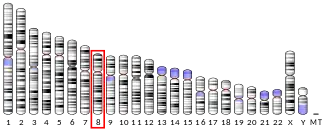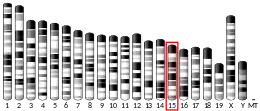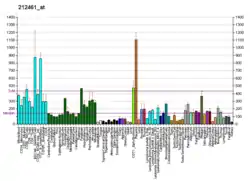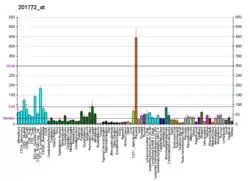| AZIN1 | |||||||||||||||||||||||||||||||
|---|---|---|---|---|---|---|---|---|---|---|---|---|---|---|---|---|---|---|---|---|---|---|---|---|---|---|---|---|---|---|---|
| |||||||||||||||||||||||||||||||
| Identifiers | |||||||||||||||||||||||||||||||
| Aliases | AZIN1, AZI, AZIA1, OAZI, OAZIN, ODC1L, antizyme inhibitor 1, AZI1 | ||||||||||||||||||||||||||||||
| External IDs | OMIM: 607909 MGI: 1859169 HomoloGene: 22933 GeneCards: AZIN1 | ||||||||||||||||||||||||||||||
| |||||||||||||||||||||||||||||||
| |||||||||||||||||||||||||||||||
| |||||||||||||||||||||||||||||||
| |||||||||||||||||||||||||||||||
| Wikidata | |||||||||||||||||||||||||||||||
| |||||||||||||||||||||||||||||||
Antizyme inhibitor 1 is a protein that in humans is encoded by the AZIN1 gene.[5][6][7]
Ornithine decarboxylase (ODC) catalyzes the conversion of ornithine to putrescine in the first and apparently rate-limiting step in polyamine biosynthesis. Ornithine decarboxylase antizymes play a role in the regulation of polyamine synthesis by binding to and inhibiting ornithine decarboxylase. The protein encoded by this gene is highly similar to ODC. It binds to ODC antizyme and stabilizes ODC, thus inhibiting antizyme-mediated ODC degradation. Two alternatively spliced transcript variants have been found for this gene.[7]
References
- 1 2 3 GRCh38: Ensembl release 89: ENSG00000155096 - Ensembl, May 2017
- 1 2 3 GRCm38: Ensembl release 89: ENSMUSG00000037458 - Ensembl, May 2017
- ↑ "Human PubMed Reference:". National Center for Biotechnology Information, U.S. National Library of Medicine.
- ↑ "Mouse PubMed Reference:". National Center for Biotechnology Information, U.S. National Library of Medicine.
- ↑ Koguchi K, Kobayashi S, Hayashi T, Matsufuji S, Murakami Y, Hayashi S (Nov 1997). "Cloning and sequencing of a human cDNA encoding ornithine decarboxylase antizyme inhibitor". Biochim Biophys Acta. 1353 (3): 209–16. doi:10.1016/s0167-4781(97)00106-1. PMID 9349715.
- ↑ Yu W, Andersson B, Worley KC, Muzny DM, Ding Y, Liu W, Ricafrente JY, Wentland MA, Lennon G, Gibbs RA (Jun 1997). "Large-Scale Concatenation cDNA Sequencing". Genome Res. 7 (4): 353–8. doi:10.1101/gr.7.4.353. PMC 139146. PMID 9110174.
- 1 2 "Entrez Gene: AZIN1 antizyme inhibitor 1".
External links
- Human AZIN1 genome location and AZIN1 gene details page in the UCSC Genome Browser.
Further reading
- Murakami Y, Matsufuji S, Hayashi S, et al. (2000). "Degradation of ornithine decarboxylase by the 26S proteasome". Biochem. Biophys. Res. Commun. 267 (1): 1–6. doi:10.1006/bbrc.1999.1706. PMID 10623564.
- Andersson B, Wentland MA, Ricafrente JY, et al. (1996). "A "double adaptor" method for improved shotgun library construction". Anal. Biochem. 236 (1): 107–13. doi:10.1006/abio.1996.0138. PMID 8619474.
- Strausberg RL, Feingold EA, Grouse LH, et al. (2003). "Generation and initial analysis of more than 15,000 full-length human and mouse cDNA sequences". Proc. Natl. Acad. Sci. U.S.A. 99 (26): 16899–903. Bibcode:2002PNAS...9916899M. doi:10.1073/pnas.242603899. PMC 139241. PMID 12477932.
- Imabayashi H, Mori T, Gojo S, et al. (2003). "Redifferentiation of dedifferentiated chondrocytes and chondrogenesis of human bone marrow stromal cells via chondrosphere formation with expression profiling by large-scale cDNA analysis". Exp. Cell Res. 288 (1): 35–50. doi:10.1016/S0014-4827(03)00130-7. PMID 12878157.
- Reuter TY, Medhurst AL, Waisfisz Q, et al. (2003). "Yeast two-hybrid screens imply involvement of Fanconi anemia proteins in transcription regulation, cell signaling, oxidative metabolism, and cellular transport". Exp. Cell Res. 289 (2): 211–21. doi:10.1016/S0014-4827(03)00261-1. PMID 14499622.
- Ota T, Suzuki Y, Nishikawa T, et al. (2004). "Complete sequencing and characterization of 21,243 full-length human cDNAs". Nat. Genet. 36 (1): 40–5. doi:10.1038/ng1285. PMID 14702039.
- Gerhard DS, Wagner L, Feingold EA, et al. (2004). "The Status, Quality, and Expansion of the NIH Full-Length cDNA Project: The Mammalian Gene Collection (MGC)". Genome Res. 14 (10B): 2121–7. doi:10.1101/gr.2596504. PMC 528928. PMID 15489334.
- Ewing RM, Chu P, Elisma F, et al. (2007). "Large-scale mapping of human protein–protein interactions by mass spectrometry". Mol. Syst. Biol. 3 (1): 89. doi:10.1038/msb4100134. PMC 1847948. PMID 17353931.
This article is issued from Wikipedia. The text is licensed under Creative Commons - Attribution - Sharealike. Additional terms may apply for the media files.





